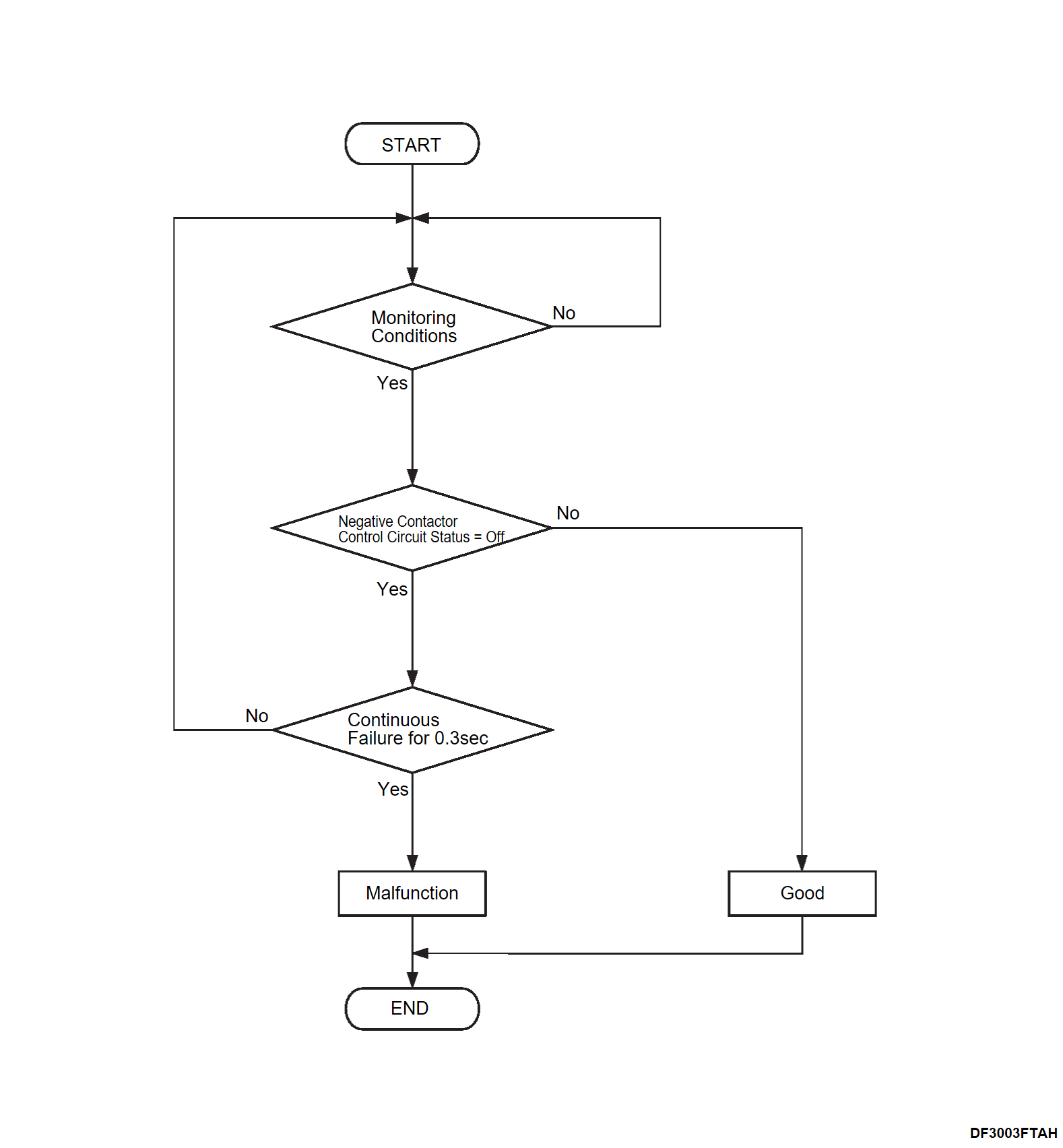DTC No. P0ADF-00 Hybrid/EV Battery Negative Contactor Control Circuit Low
| danger |
|
MONITOR EXECUTION
Continuous
MONITOR EXECUTION CONDITIONS (Other monitor and Sensor)
Other Monitor (There is no temporary DTC set in memory for the item monitored below)
- Not applicable
Sensor (The sensor below is determined to be normal)
- Not applicable
DTC SET CONDITIONS
Check Condition
- The PHEV-ECU power supply voltage is 9.0 V or more.
- Drive battery negative contactor control circuit activation command: ON
- The EV power source relay drive signal: ON
Judgment Criterion
- Drive battery negative contactor control circuit status is in OFF condition for 0.3 second or more.
OBD-II DRIVE CYCLE PATTERN
- Refer to OBD-II Drive Cycle OBD-II DRIVE CYCLE
 .
.
TROUBLESHOOTING HINTS
- Damaged wiring harness and connectors
- Malfunction of the junction box No. 2
- Malfunction of the PHEV-ECU
DIAGNOSIS
Required Special Tools:
- MB992744: Vehicle communication interface-Lite (V.C.I.-Lite)
- MB992745: V.C.I.-Lite main harness A
- MB992747: V.C.I.-Lite USB cable short
- MB992748: V.C.I.-Lite USB cable long
1.Resistance measurement at PHEV-ECU connector (CNT- terminal)
(1) Disconnect the PHEV-ECU connector (B508), and measure at the wiring harness side.
(2) Measure the resistance between the PHEV-ECU connector (CNT- terminal) and body ground.
OK: 36 ± 3 Ω [at 23°C (74.3°F)]
Is the check result normal?
2.Check of short to ground circuit in CNT- line between PHEV-ECU and drive battery
3.Test the OBD-II drive cycle.
(1) Carry out a test drive with the drive cycle pattern. Refer to OBD-II Drive Cycle OBD-II DRIVE CYCLE .
.
 .
.(2) Check the DTC.
Is the DTC set?
 The trouble can be an intermittent malfunction (Refer to General Information - How to Use Troubleshooting/Inspection Service Points, How to Cope with Intermittent Malfunctions HOW TO COPE WITH INTERMITTENT MALFUNCTIONS
The trouble can be an intermittent malfunction (Refer to General Information - How to Use Troubleshooting/Inspection Service Points, How to Cope with Intermittent Malfunctions HOW TO COPE WITH INTERMITTENT MALFUNCTIONS ).
).4.Drive battery main contactor (N) check
| danger |
|
(1) Disassemble the drive battery (Refer to SERVICE PROCEDURE ).
).
 ).
).(2) Check the junction box No. 2 (Refer to CHECK ON JUNCTION BOX No. 2 ).
).
 ).
).Is the check result normal?
 Replace the junction box No. 2 (Refer to JUNCTION BOX NO.2 REMOVAL AND INSTALLATION
Replace the junction box No. 2 (Refer to JUNCTION BOX NO.2 REMOVAL AND INSTALLATION ). Then,
). Then, 
5.Test the OBD-II drive cycle.
(1) Carry out a test drive with the drive cycle pattern. Refer to OBD-II Drive Cycle OBD-II DRIVE CYCLE .
.
 .
.(2) Check the DTC.
Is the DTC set?
 Replace the PHEV-ECU (Refer to PHEV-ECU REMOVAL AND INSTALLATION
Replace the PHEV-ECU (Refer to PHEV-ECU REMOVAL AND INSTALLATION ). Then,
). Then, 
 The trouble can be an intermittent malfunction (Refer to General Information - How to Use Troubleshooting/Inspection Service Points, How to Cope with Intermittent Malfunctions HOW TO COPE WITH INTERMITTENT MALFUNCTIONS
The trouble can be an intermittent malfunction (Refer to General Information - How to Use Troubleshooting/Inspection Service Points, How to Cope with Intermittent Malfunctions HOW TO COPE WITH INTERMITTENT MALFUNCTIONS ).
).6.Test the OBD-II drive cycle.
(1) Carry out a test drive with the drive cycle pattern. Refer to OBD-II Drive Cycle OBD-II DRIVE CYCLE .
.
 .
.(2) Check the DTC.
Is the DTC set?
 Retry the troubleshooting.
Retry the troubleshooting. The procedure is complete.
The procedure is complete.![[Previous]](../../../buttons/fprev.png)
![[Next]](../../../buttons/fnext.png)
